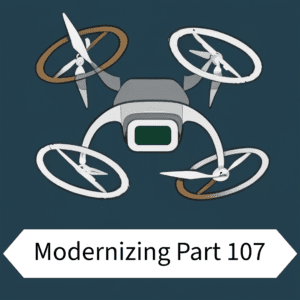Modernizing FAA Part 107 Processes

June 18, 2024
Exploring the potential of blockchain technology unveils revolutionary possibilities for enhancing the Federal Aviation Administration’s (FAA) exemption waiver process for Advanced Air Mobility (AAM) operators. By leveraging blockchain’s secure, distributed ledger system, we highlighted the potential for significantly improved accuracy, frequency, and transparency in AAM proposals, FAA assessments, and stakeholder communication. However, a crucial question remains: why is such a reliance on exemption waivers necessary in the first place?
The current FAA regulations, established in 2016, were informed by the state of drone technology. The set a framework for the commercial and government use of small, unmanned aircraft systems (UAS) weighing less than 55 pounds. The rules include operating requirements such as avoiding manned aircraft, keeping the drone within sight, and not flying over people unless they are directly participating in the operation, among others. These measures were aimed at minimizing risks to other aircraft, as well as to people and property on the ground.[1]
Furthermore, the FAA formed a Beyond Visual Line of Sight (BVLOS) Aviation Rulemaking Committee to explore advancements in drone regulations, indicating an ongoing effort to evolve the regulatory framework in response to technological advancements and operational needs of UAS. [2] The committee’s work highlights the FAA’s recognition that the initial Part 107 rules, while foundational, would need updates to accommodate the growing and evolving drone industry, including operations beyond the operator’s visual line of sight, which were not fully addressed in the 2016 regulations.
The industry has since witnessed remarkable advancements in flight performance, payload capabilities, software, and communication. This begs the question: why do certain regulations linger, potentially hindering innovation?
Consider the 2016 requirement for constant visual line of sight (VLOS) and daylight operations. These limitations aimed to maintain adequate situational awareness for operators. However, the emergence of technologies like LiDAR, which create real-time 3D maps using lasers, has rendered VLOS less relevant. Similarly, advancements in night vision, thermal imaging, data transmission, and lighting systems have paved the way for safer nighttime drone operations.
The key characteristic of FAA regulations lies in their “reality-based” nature. Unlike prescriptive rule sets, they adapt to technological advancements based on documented evidence of successful implementations. This is where blockchain could play a pivotal role.
Currently, no singular repository exists to consolidate data from successful drone operations approved under exemption waivers. Consequently, substantial data sets proving the feasibility of regulatory changes remain elusive, hindering significant updates to Part 107.
Enter blockchain – a secure, transparent platform capable of compiling and presenting comprehensive data sets to FAA rulemaking teams. Centralized access to documented successes in advanced drone technologies could serve as a powerful catalyst for regulatory amendments that are significantly influenced by public awareness and acceptance. With streamlined regulations, the need for frequent exemption waivers would diminish significantly. This, in turn, would benefit all stakeholders:
- FAA: Reduced bureaucratic burden due to fewer waiver requests.
- Drone Operators: Less red tape and streamlined operations.
- Technological Landscape: Enhanced freedom for innovation within a safe regulatory framework.
Blockchain transcends its role in streamlining the waiver process. It presents a transformative opportunity to bridge the gap between technological advancements and regulatory realities, unlocking the full potential of AAM and fostering a robust drone ecosystem where safety and innovation flourish together.
Interested in learning more about our thoughts on this? Reach out to our Aerospace Department today!
